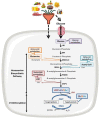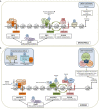Regulation of Polycomb Repression by O-GlcNAcylation: Linking Nutrition to Epigenetic Reprogramming in Embryonic Development and Cancer
- PMID: 30873122
- PMCID: PMC6400832
- DOI: 10.3389/fendo.2019.00117
Regulation of Polycomb Repression by O-GlcNAcylation: Linking Nutrition to Epigenetic Reprogramming in Embryonic Development and Cancer
Abstract
Epigenetic modifications are major actors of early embryogenesis and carcinogenesis and are sensitive to nutritional environment. In recent years, the nutritional sensor O-GlcNAcylation has been recognized as a key regulator of chromatin remodeling. In this review, we summarize and discuss recent clues that OGT and O-GlcNAcylation intimately regulate the functions of the Polycomb group proteins at different levels especially during Drosophila melanogaster embryonic development and in human cancer cell lines. These observations define an additional connection between nutrition and epigenetic reprogramming associated to embryonic development and cancer.
Keywords: O-GlcNAcylation; Polycomb; cancer; drosophila development; epigenetic.
Figures


References
Publication types
LinkOut - more resources
Full Text Sources
Molecular Biology Databases
Miscellaneous

